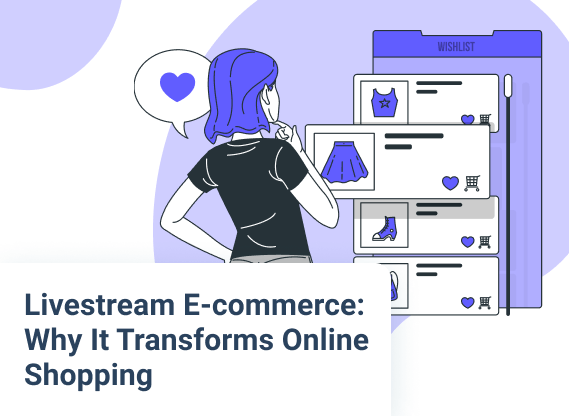
Want to know more? — Subscribe
E-commerce technology trends in 2024 promise innovative developments that will further transform the online shopping and selling experience. The industry has experienced explosive growth over the past few years, with no signs of slowing down. Its revenue in the US only, estimated at $900 billion in 2023, will reach over $1.5 trillion in 2028.
Consumers continue to opt for online shopping, and sellers expand their digital operations. And 2024 brings new solutions for companies to remain competitive. From social media stores to virtual reality, businesses will need to adopt these technologies.
For this guide, Softermii leverages its ten years of expertise in e-commerce development, delivering successful products such as Streamotion, Dollar Shave Club, and Esthetic, among others. Companies may use this experience for insights into creating progressive solutions.
Let's explore 9 key technology trends in e-commerce shaping the industry in 2024. Understanding them provides insight into future opportunities and allows businesses to plan effective strategies. The coming years promise exciting innovation in the world of digital commerce.
Why E-commerce Technologies Are Driving the Future of Sales
The popularity of online retail is directly related to the emergence of new e-commerce technologies. Online shopping has become more convenient than ever. It is not surprising that the e-commerce sector is growing by more than $57 trillion in the 2023–2032 period.
The projected growth rate for US B2B e-commerce website sales is 19.2% from 2023, reaching $36.1 trillion in 2031. Not only online sales but customer demands are rising as well. The boom in online stores proves this. And that's 26.5 million e-commerce websites worldwide.
Acquiring new customers may be six to seven times more expensive than keeping current ones. Customers are getting used to the convenient experience of shopping online, so investing in technology in e-commerce is very promising. Let's look at the features and trends already transforming the industry to determine which technologies are worth the investment.
Key Technology Trends in E-commerce for 2024
E-commerce has a future, and it's bright. Yet, to get there, you need to know which path to take. We will help you start by presenting the latest e-commerce trends in 2024.
Read Also: E-commerce Platform Development: Ultimate Guide
Social Commerce
Social networks have long been more than a tool for communication. They open up new business opportunities like marketing your brand, providing customer support and encouraging your clients to shop.
Thus, social commerce is selling goods directly on social networks. This online retail option offers an entire purchasing experience, from product discovery to payment.
60% of consumers expect to buy goods directly on social media. Thus, companies should start using shoppable tags and in-app transactions. The reduction of shopping friction allows users to find and buy products quickly.
Over 110 million Americans buy goods on social media, with Facebook being the most popular. Given that this is already a large number of buyers, it will continue to grow further.
Statista predicts that social commerce revenues will reach $8.5 trillion by 2030. It is approximately seven times more than in 2023.
TikTok is also a viable sales platform and is largely driven by Gen Z. After one month from its launch, around 10% of US responders made a purchase via TikTok Shop. Yet, due to its young audience, it's Facebook that remains a top choice for consumers of all ages.
Livestream Commerce
Remember the TV shopping channels? Livestream commerce is exactly what you think it is.
It is a video streamed on a commercial platform where the host shows viewers different goods in real time. The audience can easily buy products directly on the shopping site.
This type of e-commerce is the most popular in China. For example, in 2023, over 100 million members joined the platform during the Global Shopping Festival on Taobao. Companies in the United States have also noticed a tendency toward this upgraded version of 'shoptainment.' By 2026, live online shopping is expected to generate nearly triple the e-commerce revenues, reaching $55 billion.
With this approach, you can present items in all dynamics. And creating limited-time offers or limited-quantity products will generate client interest even further. You may also answer questions about the products in real time.
Read also: How to Integrate Livestream Commerce into Your Existing Website
BOPIS or Click and Collect
BOPIS, or 'buy online, pick up in-store,' is another one of the new trends in e-commerce technology. This approach involves buying or reserving goods online and picking them up at a pickup location. For businesses, click-and-collect means less money spent on delivery as more people visit physical stores.
In the United States, 2023 click-and-collect sales were evaluated at $99 billion. By 2026, the figure is expected to reach $131 billion.
Buy Now, Pay Later (BNPL)
Buy Now, Pay Later service is one of the emerging technologies in e-commerce. It allows customers to purchase the goods in interest-free installments.
Such a service became especially popular during the pandemic, as people needed alternative funding sources and flexibility. Customers preferred not to use their credit cards when shopping, so BNPL became an ideal option. The following chart illustrates that two-thirds of Americans have used or plan to use this service.
There are different types of BNPL:
- One such type is direct providers of such services as Afterpay and Klarna. These providers are largely responsible for BNPL's popularity.
- Another type involves facilitators. These payment companies function as intermediaries and incorporate their services in the BNPL infrastructure. The most popular organizations are Mastercard, Shopify, and Stripe.
- The last type of BNPL is retroactive service providers. They offer flexible payment options for the buyer's credit card after shopping. One such company is American Express.
Buy now, pay later is gaining popularity; in 2032, it may reach $9.2 trillion worldwide.
Read also: Buy Now, Pay Later App Development
Mobile Shopping
Mobile shopping is not just one of the retail tech trends; it is today's reality. Every day, the role of smartphones in e-commerce is becoming more significant. It happens because more consumers make purchases using their phones.
Although users continue to shop through the computer, the smartphone will eventually become critical in online retail. 70% of retail e-commerce sales will go through mobile phones in 2024, making up about $4.5 trillion.
So, if you are engaged in online retail and have not yet created a custom mobile application, pay attention to this trend.
Read also: E-commerce App Development Guide
Progressive Web Apps
A PWA technology allows you to create web applications that look like native mobile applications. Developers use web technologies such as JavaScript, HTML, and CSS when building these solutions.
Retail giants such as Alibaba and Walmart have used PWA to generate more revenue and increase conversion rates. Yet, progressive web apps are perfectly suitable for small and medium-sized organizations.
PWA's primary functions include:
- Application access through the smartphone's home screen
- Offline application access
- Push notifications
Interestingly, according to the Statista survey of e-commerce companies, 17% have already invested in PWAs or plan to do so. 28% of businesses still evaluate their opportunities.
Here are a few benefits of progressive web applications:
Capability to reach a broader audience
PWAs readily adapt to different screen sizes and work on any platform. They are accessible to many users, which benefits the e-commerce company.
Cheaper and faster development
The PWA, as previously said, operates on any platform. Android, iOS, Windows, or macOS are all possible. Instead of creating many app versions, make one universal progressive web application.
Speed and responsiveness
Users value websites that load quickly. People tend to abandon a site that takes a lot of time to load. PWAs are designed for instant and seamless operation and can function even without an internet connection.
So, PWA is a prominent alternative to native mobile applications and regular websites. Implement it in your online shopping technologies to improve users' buying experience.
Read also: 10 Things to Know Before Developing E-commerce Website
AI-Powered Personalizations
Personalization is a critical aspect of increasing business profitability. Around 56% of consumers may repeat their purchase if the retailer offers an individual shopping experience. One of the latest technology trends in e-commerce, AI allows you to personalize your online store.
AI can improve product and search recommendations, segmentation, customer support, and more. It, in turn, will significantly increase the effectiveness of your brand. With AI and machine learning analytics, you can manage customer behavior patterns, interpret user data, and thus make personalized recommendations.
Where you can use artificial intelligence:
- Voice assistant. Consumers frequently use it to search for the product they need. AI must comprehend the customer's search queries and provide the most relevant results.
- AI-powered chatbots. E-commerce chatbots are about improving the customer experience and enhancing the brand image. These virtual assistants can provide order status information, respond to user queries, and help with purchases.
AI Content Creation
One of the most recent e-commerce tech trends for 2024 that we will talk about is AI-based content creation. We already know that artificial intelligence helps personalize the shopping experience, but what else can you do with this innovation?
Ross Beyeler, COO of Trellis Commerce, is convinced that artificial intelligence will be the component that will bring automation and scale to content-making and brand marketing.
Trellis Commerce's chief operating officer believes that artificial intelligence can be helpful in the following areas:
- Visual design. These are, for example, tools such as Synthesia or Designs.ai, which use AI to create logos and video content.
- Advertising campaigns. AI used by such services as Pencil, Bannerbear, or EXOD automates advertising campaign creation, testing, and optimization.
- Content marketing. Frase and Jarvis, which use AI technology, help salespeople create copies of a blog, product, or landing page.
Generative AI
Using generative AI, e-commerce shops can create text, images, or videos with a few taps. This technology helps generate product descriptions, personalized marketing messages, and visual content.
What are the benefits of Generative AI in e-commerce? Here are a few examples:
- Personalization and Product Recommendations. AI systems analyze past behavior and recommend products tailored to individual tastes. This personalization drives higher sales through better-targeted marketing efforts.
- Dynamic Pricing and Demand Forecasting. One of the AI capabilities is the analysis of market demand, competition, and customer behavior. It allows for product price adjustments in real time.
- Enhanced Customer Service. AI-driven chatbots provide instant responses to customer inquiries. This 24/7 support system improves customer satisfaction.
- Content and Marketing Strategy Automation. Generative AI can make up product descriptions and custom marketing emails. It automates different aspects of content strategy, freeing up staff for other strategic tasks.
Virtual Reality and Augmented Reality
Integrating VR and AR in e-commerce offers greater interactivity, personalization, and engagement. It enhances customer experiences and boosts sales, fostering innovative marketing strategies.
Virtual Reality can transfer users from the physical world into a simulated environment. This way, customers can explore products in a virtual space. Shops can offer unique experiences, increasing customer engagement and brand loyalty.
As customers can view products in 3D, they better understand the look, feel, and functionality of goods. E-commerce platforms can also use VR for product launches or promotional activities, attracting a wider audience.
AR, in contrast, layers digital elements onto the real world. This approach allows for a more widespread application due to its smartphone compatibility. No wonder the AR market hit $56 billion in 2023 and may exceed $1.1 trillion in 2032.
Customers can visualize products in their own environment, such as furniture in a room. AR provides an interactive element to online shopping as users can engage with products in a more hands-on manner. This approach reduces the uncertainty associated with online purchases.
Emerging Technology Trends for the E-commerce Security
The internet is full of opportunities for both business owners and threat actors. But why should you take care of your online store's safety? Let's discuss the hazards and new technologies used in e-commerce security.
DDoS attacks are no longer the sole domain of modern cybercriminals. Hackers are developing increasingly complex and powerful methods of harming businesses. As a result, every retailer should consider securing their online store.
Threats to online retail platforms that currently exist:
More Sophisticated DDoS Attacks
Many of your online store's activities may slow down if an attacker forces your site to go down and not respond to user queries. It will result in lost revenue and disappointed consumers.
Weak VPN Servers
Severe DDoS attacks usually cause a lot of public disturbance. But hackers know another quiet way to harm the online retail platform. If employees working remotely connect to the system using a VPN, they can be a line of focus for an attacker. An intruder can disrupt the remote workforce by disabling a VPN server.
Hacktivism
Hacktivism is a hacking technique used to spread the political agenda. Why should business in e-commerce be concerned? At least because of capitalism's negative impact.
Security Personnel Shortage
Security professionals must keep your store safe and sound. Arranging an attack on your e-commerce platform is easier when you do not have such specialists on site.
Omnichannel Marketing
It is the simultaneous delivery of promotional messages over many channels. For example, you communicate your brand through social media, email, and so on. Yet, with several channels, the risk of attackers intercepting your messages is higher.
Fraud
Phishing is the most common type of fraud. By sending fake links, fraudsters can get personal information from your consumers, including bank account details.
Now that you've learned about the vulnerabilities of current e-commerce platforms, you should be able to protect your online store. Let's discuss the most significant technologies, trends, and security strategies for 2024.
Consider a Strategy Against DDoS Attacks
A well-thought-out action plan will help you and your workers quickly navigate during a DDoS attack. This way, you'll rapidly identify the problem, suffer minimal harm, and swiftly restore your retail platform.
Set Your Traffic Baseline
When considering traffic management methods, train your personnel to spot DDoS attacks. That is, if your team is familiar with the baseline level of traffic on your platform, they will be able to detect any variations from the average promptly.
Familiarize Your Customers with Cybersecurity
Teaching your employees to recognize suspicious activity on the platform is not enough. Don't forget to take care of your customers as well. Phishing and other scams are becoming more widespread, so inform your customers of the potential threats.
Increase the Security by Using APIs
Online stores can improve customer recommendations and target advertising by collecting user data. However, this data needs to be well-protected. It would be smart, for example, to handle payments through third-party gateways.
Add Multiple Levels of Security to Your E-commerce Platform
You may use the following security strategies to enhance the safety of your online retail platform:
- VPN
- Two-factor authentication
- Anti-spam
- Firewalls
- Malware protection programs
- Content filtering
- Load balancing
Use Cloud Providers for Traffic Overflow
Let's go back to the massive DDoS attacks. There is a strong likelihood that the local equipment will not survive and fail because of these attacks. Thus, we recommend considering third-party vendors with cloud-based servers. Why? First, the cloud has more bandwidth. And the risk of crashing during a DDoS attack will also be lower.
Simulate a DDoS Attack to Test Your Online Store Security
It is the final step in protecting your e-commerce platform. After you have provided all the security measures outlined above, run the simulation. Thus, you may assess how secure your platform is at the moment. Also, it's much easier to correct any weaknesses in your security.
Industry-Wise E-commerce Trends in 2024
Technologies influence all e-commerce niches: beauty, food, retail, and others. Let's look at the e-commerce technology list and trends for each industry.
B2B E-commerce
The B2B sector will pay significant attention to pricing personalization, particularly real-time pricing. This niche will also adopt in-depth customer journey analysis, faster order fulfillment, and explore how to integrate supply chain processes seamlessly.
Beauty E-commerce
This niche will focus on diversity and increased product personalization. The main goal for 2024 is to bridge the gap between online and brick-and-mortar beauty stores.
Food E-commerce
Some e-commerce technology examples in this niche include the increased digitalization of food-related services. So expect to see more food delivery and restaurant booking apps.
Retail & Grocery E-commerce
Livestream shopping will definitely gain traction in 2024. Purpose-driven retail brands will also take the stage.
Automotive E-commerce
Expect more automotive companies to apply technology used in online shopping, especially mobile-friendly solutions. Virtual showrooms will become popular as well.
Softermii's Experience in E-commerce Technology
We are confident that the growth of any online retail business significantly depends on the adoption of innovation. Our team has successfully assisted many companies with this. We constantly follow e-commerce B2B trends and tech tendencies to build effective, one-of-a-kind solutions.
Our team is sure that innovation in e-commerce is a great way to reach a new audience. For example, you can expand your customer base by adding a mobile application to your online store's website. We are ready to assist you in this regard.
Speaking of mobile apps, our company has an extensive background in mobile commerce. We acknowledge that the customer experience should be as smooth as possible.
Our UI/UX designers, in turn, will take care of your online retail platform, making it clear and simple. We realize all the discomforts that consumers may experience, so we do everything to keep them from encountering incomprehensible designs.
Here are some of our prominent cases in the e-commerce field:
Dollar Shave Club
The Softermii development team has created the e-commerce app Dollar Shave Club. It provides men with personalized packages and delivery of razor blades, handles, aftershaves, and other male shaving products.
Challenge
The client had an inefficient and poorly designed mobile app that users didn't like. And we needed to fix that. We had to redevelop the mobile app from the ground up.
Solution
Our expertise in mobile app development helped us set a clear action plan. Apart from creating an Android app, we A/B tested it to secure great performance results across all devices and social user groups. Our dedicated team helped boost the Dollar Shave Club's conversion rates.
Besides the updated design, our specialists have added several new features to the application:
- Buying shaving products in 1 click
- Scanning of a credit card for payment
- Sending a gift to the user's male friends using the mobile app
Result
The results of our work appeared quickly. The number of people using the app increased from around 3,900 to over 500,000. Moreover, our team helped the company get acquired for a billion US dollars.
Esthetic
Esthetic is an online retailer of female underwear that offers worldwide shipping, user-friendly design, multi-warehouse support, and AI-powered content personalization.
Challenge
Our team had to deliver an intuitive app with an effortless 3-step checkout process. Other challenges included the development of an AI algorithm for content personalization and multi-warehouse support integration.
Solution
We've created a Magento module for the fast and simple design of application pages. Our experts have also integrated Magento 2 payment 3-step checkout and developed an AI algorithm that personalizes content according to buyers' search queries. We also implemented multi-warehouse support for faster shipping.
Result
Our team created a scalable and performant e-commerce app that offers exceptional usability for buyers.
Streamotion
We leveraged the livestream commerce trend and successfully implemented it in our Streamotion app.
Challenge
Our team had to enter the emerging livestream commerce market and build a mobile app using video broadcasting technologies. We also had to implement group broadcasts and social features like messaging and feed.
Solution
We used our WebRTC-based VidRTC engine to implement live streaming and broadcasting features, including group broadcasts. Our experts also took care of text chat, feed, and payment integrations.
Result
Riding the trend wave, Streamotion got considerable achievements. The app had 20,000 installs in just two weeks after launch and gathered about 80 sellers.
Final Thoughts on E-commerce Technology Trends
As we look ahead to 2024's advancements, online sellers should follow the latest technology in e-commerce for sustained revenue growth and exceptional customer experiences.
Key innovations like social commerce, livestream shopping features, BOPIS, BNPL, m-commerce, PWAs, AI-powered personalization and content creation tools, and VR/AR environments will all provide new opportunities.
The team at Softtermii knows the challenges and possibilities that brands may face when implementing them. Contact our e-commerce experts for custom solutions and guidance to secure long-term success.
Frequently Asked Questions
What technology is used in e-commerce?
E-commerce uses innovative technologies in 2024 such as social commerce, livestream commerce, BOPIS, Buy Now, Pay Later (BNPL), mobile shopping, AI-powered personalizations, AI-content creation, VR/AR, and much more.
What future e-commerce technology will become Top 1 in 2024?
Social commerce is expected to be the most in-demand e-commerce technology in 2024. This is due to the fact that every year more and more purchases on the Internet occur through social networks.
What technology is used in e-commerce websites the most?
For e-commerce websites, the most popular innovation in e-commerce is the use of progressive web applications. It is this trend that is now in high demand among eCommerce developers.
What e-commerce trends are most often used by developers when creating solutions?
Now, most e-commerce development companies often use artificial intelligence technologies, implement technologies such as BNPL, and develop progressive web applications when creating e-commerce solutions.
How about to rate this article?
1745 ratings • Avg 4.9 / 5
Written by:

























